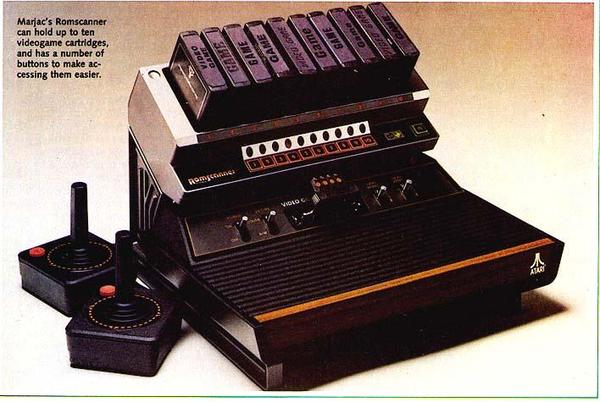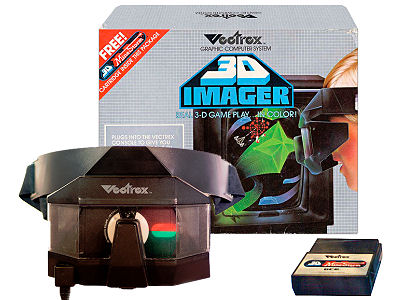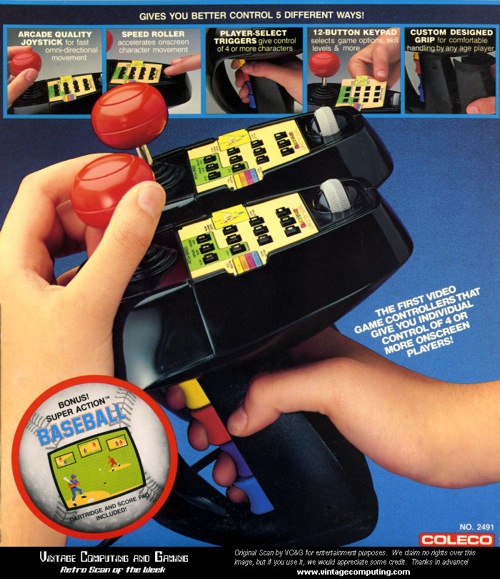10 Deservedly Forgotten Videogame Peripherals
 |
?Since the dawn of home videogaming, peripherals have been a very important part of the success or failure of a console. Part of the appeal of the Atari 2600 was its simple controller, which was much more responsive and easy to use than its competitors’ (such as Intellivision and Colecovision). We’ve certainly come a long way from the simple directional pad with four buttons of the original NES; since then, both games and their accessories have become increasingly complex. As a result, peripherals have gotten equally complex, and, at times, pretty bizarre.
Now we’ve all seen some crappy peripherals in our time: the Dollar Store Wii Tennis Racket, the Nintendo R.O.B., numerous crappy light gun Wii-Mote shells, and of course the Power Glove. And of course we know that cheap peripherals generally suck no matter what. But here is a list of some of the gaming peripherals you probably forgot, tried to forget, or missed entirely. Most are old, a few are pretty recent. But they all have one thing in common — no one misses them.
10) The Steel Battalion Controller
 |
?
I feel bad knocking Steel Battalion, because out of all of the entries on this list, 2002’s Steel Battalion controller was the coolest. As an anime/Battletech nerd throughout my childhood, there wasn’t anything available to me to truly simulate piloting a ‘mech until this monster came out. The specialized controller consisted of two flight stick style joysticks, 40 buttons (most of which could light up), one dial, a gear shift lever and three foot pedals. Because of the layout, you had to sit the controller on some sort of table, along with room for the pedals, so you needed a pretty large space to be able to play.
You also needed a great deal of money. At $200, it cost almost as much as the Xbox itself. Also it only supported Steel Battalion and its sequel, Steel Battalion: Line of Contact. Third, the game itself was really frigging hard. Before combat started, you had to power up your mech by entering a complex sequence into the controls. While this was cool in the beginning, missions that involved defending against a surprise attack had you taking hits before you could even start your mech. And if you died without getting to the eject button in time, your character died along with you. On mission 2, this was not a big deal, but if you were at the end of the game, you had to start over from the beginning. Perhaps if they had made a controller that was a bit less complex it would have worked better, although its complexity was its main draw. Recently Capcom announced that they intended to return to the Steel Battalion universe, this time utilizing the Xbox Kinect control system — kind of the polar opposite, control-wise.
9) Commodore Datasette Player
 |
?
The Commodore 64 was the first mainstream computer that made it into American homes. It was small, not incredibly expensive, and simple enough for most people to learn how to do computing basics. It was versatile and allowed for multiple types of storage medium, including Atari-like cartridges and floppy disks and even cassette tapes. Yes, the Commodore Datasette Player actually stored and read information from your typical audio cassette. The player was less expensive than the 5 ?-inch floppy disk drive, and the media could be found just about anywhere, and at a reasonable price.
Unfortunately, while most 1980s storage media was slow, the datasette was about 100 times slower. Because of the analog nature of the recording medium, the operating system had to search the entire tape for whatever program you were looking for. You would type in your command, and the computer would ask you to “Press Play on Tape.” You did… and then you waited. And waited. And waited. Now to be fair, once the program was loaded into memory, it would run at full speed without further delay. The problem is, if you were running a program at the end of the tape, then wanted to run one at the beginning, you had to rewind the tape, and the computer would have to search the whole thing again until it was loaded. Now there was a trick to this — by keeping track of the tape decks numerical counter, you could cheat and have the tape closer to the position where the data you were looking for was located. I never did this though, because I was 6 at the time, and was not that smart.
8) Gameline
 |
?Long before the days of Xbox Live, Steam and PSN, the only way to purchase games was in a store; particularly in the early days, your choice of retailers was pretty limited to toy stores. But in 1983 came Gameline, what could very well be the first online videogame service. The concept was simple: insert an oversized modem/ram cartridge into your Atari 2600, attach a phone line, and then connect it to rent from a rather large selection of third-party games. The games were downloaded and stored on the cart until your rental time was up, between 5 and 10 days. Apparently the creators of the Gameline were pretty ambitious; the service was supposed to add news, sports scores, stock quotes, and even an early form of e-mail, but these features were never implemented.
Why not? Because this thing came out in an era when the average joe had no clue what a modem was. The first time most people even heard of a modem was when Matthew Broderick was hacking the WOPR in Wargames. The idea of hooking up your phone to a videogame system was baffling to most. Add to that the great Video Game Crash of 1983, and you have a dead-on-arrival peripheral. Interestingly enough, this wasn’t the end for the company who created Gameline. Apparently the founders of the company went on to form Q-Link, a Commodore-based online service, which later became America Online.
7) Romscanner
 |
?To lazy to change your Atari 2600 cartridges? Have no fear, here comes the Romscanner! The Romscanner was a large Atari cartridge jukebox-like device, which when plugged into your 2600’s cartridge slot, would allow you to select from up to 10 games that you could load into its slots. I guess this was to combat the enormous inconvenience involved in getting one’s fat ass off the couch to remove and insert a new game. According to the box, the Romscanner also eliminated waiting between switching games, although I don’t quite remember the Atari 2600 having particularly long load times.
Never, in all of my time playing my old Atari 2600, did I ever think “If only I didn’t have to get my fat ass off the couch to change games.” Okay, I can vaguely see where this would come in handy… if your kids constantly lost their favorite games, if you only had 10 games to begin with etc. But if you wanted to switch between your pre-loaded 10 games, you still had to get up and hit a button, so this thing saved you maybe 20 seconds max. Another issue is that some of the more oddly shaped games from third-party companies wouldn’t fit properly in the unit; while this may not seem like such an issue, a lot of the better 2600 games were from third-party developers. Now, had this device had a remote control of some sort that allowed you to change games from a distance, it would have been the ultimate in 1980s lazy ass gamer design (that accolade went to the Atari 5200’s pause button, which finally allowed players a chance to go to the crapper mid-game.)
6) Vectrex 3-D Imager
 |
?The concept of 3-D entertainment seems to come and go in waves. Popular in the ’50s, and popping back into popularity in the ’80s, 3-D entertainment was gimmicky at best in those days (and can still be considered to be a gimmick). But the idea of being able to play videogames in 3-D was a pipe dream until the invention of the Vectrex 3-D Imager in ’82. Most people will not remember the Vectrex, the first portable videogame system which featured a built-in black and white vector monitor. This is sad because the Vectrex was one of the best systems from the ’80s, and its 3-D imager made it possible to play specifically programmed games in a pseudo-3-D view.
The concept was pretty fascinating; you donned this rather hard-to-describe headwear, which had a spinning color wheel mounted in front of the eyepiece. The wheel spun in sync with the data from the game, and simulated 3-D by allowing each eye to view a different picture, giving the illusion of depth. While it may have looked cool from the inside, from the outside you looked like some nerdy Luke Skywalker staring at a small box with the blast shield down.
The problem was the price — at $80, it was almost half the price of the system — and again, the videogame crash of 1983. There were only three games released for it, so it was rendered useless almost overnight (although since then there has been some homebrew love).
—-
5) Para Para Paradise Controller
In the late ’90s, Dance Dance Revolution ruled Japanese arcades, and slowly made its way to the U.S. Eventually the craze became big enough that Konami could officially release a Dance Dance Revolution game for U.S. consoles, along with its trademark dancing pad, and they both actually sold pretty well. It’s easy to see how Konami thought America might be accepting of Para Para dancing, which had eclipsed DDR in popularity in Japan in the early ’00s.
For the uninformed, Para Para is a type of synchronized dance, featuring mostly arm movements. Fueled by hyper-fast Eurobeat music tracks, squads of dancers would line up and flail about in unison. It’s kind of a combination of cheerleading, line dancing, and high-pitched music for tweenage Japanese girls, and no, America was not accepting of it.
The controller consisted of five hot pink, plastic flower-like objects
that, like the Sega Activator (below), shot IR beams in the air and registered when
something intercepted them. You set them in a half-circle around
you, and before you knew it, like Billy Idol, you were dancin’ with
yourself. Para Para Paradise was never released in the U.S., but that didn’t stop people from importing it, although it was extremely expensive, and only the one title was released for it. Experts looked awesome playing, but novices looked like puppets having epileptic fits. Ironically, with the invention of superior motion based controls like those found in the Wii, the Kinect, and Playstation Move, similar dancing games like the Just Dance series are now becoming immensely popular. Sorry, Konami! You were just a tad early.
4) Colecovision’s Super Action Controller
 |
?Bigger is not necessarily better (something Microsoft discovered after it released the first Xbox controller). When the Colecovision was released, it was not particularly lauded for its controllers; Colecovision’s answer to this was to make the biggest fucking controller possible. 1982’s Super Action Controller was about as large as Andre the Giant’s fist and packed four rainbow-colored trigger buttons, a 12-button keypad, a “speed control” wheel, and a big red-balled control stick. It also featured variously-sized pistol grips to ensure that people of all sizes could use the plastic boxing glove of Doom. It even boasted the ability to control more than one player at a time in certain compatible games.
Why did it fail/suck? Look at it… just look at it. In an era where videogames were considered kid’s stuff, this controller was designed specifically for the 6’10”, 325-pound sumo wrestler. And to make things worse, they were generally sold in pairs, so you got double the suck. I actually had a friend who had a pair of these with his Colecovision, and he opted to play with the horrible standard controllers rather than even try to unbox this peripheral behemoth. Bottom line, most kids couldn’t use them well, and the videogame crash of 1983 put the nail in the coffin for the Colecovision and all of its bastard children.
3) Rez Trance Vibrator
The second entry on the list from the music game genre, this one was also only available in Japan, back in 2001. Rez was a unique shooting/music/rhythm game with great electronic dance music and unbelievably trippy visuals; if Frequency and Virtua Cop had sex while on LSD, Rez would be the product. But Rez went to extremes in order to get you to feel the beat, as the special edition of the game included a USB-powered vibrator. Now, why would you have a vibrator in a videogame? Well, according to the instruction manual, you were to place the Trance Vibrator in your “pocket” and it was supposed to let you “feel” the music. But if it was supposed to go in your pocket, why did it need a protective sleeve?
I guess the idea was to make videogaming more interesting for poor neglected Japanese women who were ignored by their husbands/boyfriends in favor of videogaming. In reality, it was just really, really bizarre. Alas, the Trance Vibrator never made it to the U.S., or past the PS2 version, as the Dreamcast and other versions of Rez have all been sold vibrator-free. And no, I have no idea why this commercial for Rez and its Trance Vibrator features two shirtless Japanese dudes. None at all.
2) The Sega Activator
Motion control was thought up long before the Wii. Atari had the Mindlink (which never made it to stores), Nintendo had the U-Force (which should have been branded the U-Suck), and Sega had the Activator. Developed originally to be a new wave musical instrument called the “Laser Harp,” it was retooled in 1993 for the Genesis. Basically, you stepped into an octagon placed on the floor in front of your TV. Infrared beams shot out of the Activator, and by moving parts of your body overtop the IR beams, you caused your character to move. It was touted as the ultimate controller for fighting games, with special compatibility built into Mortal Kombat, Street Fighter 2 and Eternal Champions, the GoBots of Sega fighting games.
The problem was in 1993 videogames were predominantly played by young boys, who were 1) not interested in getting a workout 2) often played videogames to avoid physical activity and 3) were not interested in looking like complete tools when playing videogames. Even if they purchased one, most players would either be annoyed by the horrible accuracy of the control, or worn down by sheer exhaustion — playing Mortal Kombat was bad, playing Sonic the Hedgehog was more like being tortured in the Seventh Layer of Hell. And to imagine, people spent $80 on this medieval torture device.
1) Mojowijo
 |
?Sex sells. Sex sells in videogames, too… but only sometimes. Don’t think so? Just look at the amount of news time GTA: San Andreas got and the number of copies sold when the Hot Coffee incident was made public. But when Girls Gone Wild-esque The Guy Game came out in 2004, the normally horny public (thankfully) ignored it. Who knows what sex-incorporated video game will sell, and what won’t? It’s difficult to say, but the Mojowijo is clearly in the “won’t” category. Admittedly, it’s less a videogame peripheral than a hack to an existing peripheral — you attach one of the “modifications” to your WiiMote, connect it to your PC through Bluetooth, and with the Mojowijo software, you can wirelessly control your “device” or your partner’s “device” through the interwebz.
The problem is that it’s a lot of work for just jerking off. Plus, the remote control aspect does not make up for the fact there are many, many other sex toys that are more enjoyable and comfortable, even if you’re just going to use them during a Skype session. Besides, once you’ve stuck your Wii-Mote to your genitalia, it can be difficult to play Super Mario Galaxy without feeling like the controller is kind of sticky. Best stick to manual, don’t you think?
